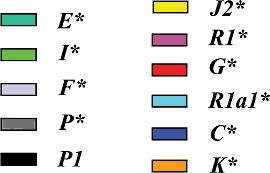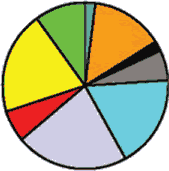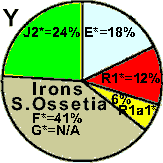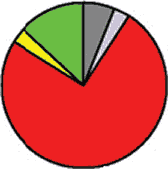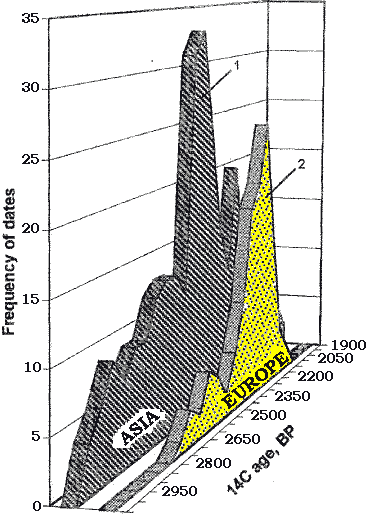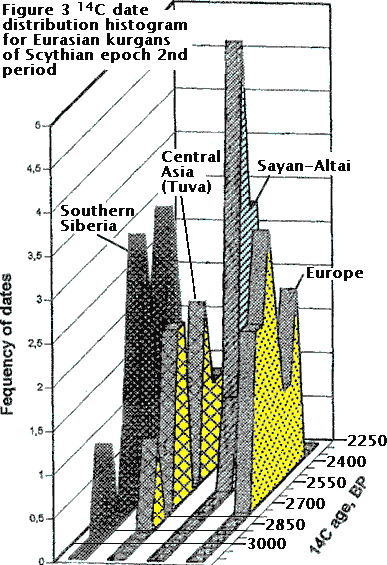Agusti Alemany
“Sources on Alans“
2000
1
1.1. The Ethnic Name *al[l]an-
5
1.2. The Ethnic Name *as-
In central Caucasus there still lives a singular people, the Ossetes, whom all the evidence points to as descending from the Medieval Alans.
| There are 4 problems with this brief fundamental statement: 1. In connection with “As” ethnonym, two more people have a direct association: Azeri (“As-Eri”, etymologyzed in Türkic “As-People”, and whose endoethnonym Azeri continues to the present, and Balkars (dialectal form of “Bulgars”, whose general endoethnonym is “As”. 2. Ossetes' endoethnonyms are Digor and Iron, no connection with “As”. Ironically, Ossetes use the ethnonym “As” for their neighbors, Karachai-Balkars. They do not even own their supposedly own name. 3. Not “all the evidence” points to Ossetes descending from the Medieval Alans. Actually, the evidence is entirely missing, while significant evidence points to the opposite. The most powerful evidence is that the term Ossete is of a Russian origin dating to the mid-1820s, and used by the Ossettes as an endonym only with the introduction of the Stalinist passportization in the 1930's. It took generations and repeated registration and passportization to induce people to get used to the new politonym, and now each Ossette has 2 or even 3 ethnonyms. Before that, the term As was used by the Ossetes exclusively for the Balkar-Karachai people: As for their Türkic Balkar neighbors, and Ghara-As (Kara As ~ Black As) for their Türkic Karachai neighbors. 4. The tribal name of the people was As “people”, “tribe”, their location was alan ~ steppe. The confederation called Alan “Flat-landers”, like any other confederation, consisted of numerous ethnic tribes with their own endonyms (we know Iazuges, Rhoxalans, etc.), while the tribe As at different times belonged to a variety of political entities: As-Tokhars (2nd c. BC), Türkic Kaganate (6th c. AD), Khazar Kaganate (8th c. AD), Alans (2nd c. AD, 9 th c. AD). Alans are also known as horse nomadic people, while the Ossettes are exclusively sedentary as far as sees the eye. Confusing one with the other is nothing but a trouble. |
According to the 1979 census, about 480,000 of them speak a North East Iranian language - the last traces of ancient Scytho-Sarmatian - which has two main dialects, Digor or West Ossetic (Oss.D. Digoron ceviag) and Iron or East Ossetic (Oss.I. Iron cevzag). While Iron is the dialect of the majority, Digor is more archaic and therefore the one most used in the reconstruction of the language of the Alans; both are found surrounded by Caucasian (Georgian in the South, Kabardian and Circassian in the North and West, Ingush and Chechen in the East) and Turkic (Nogai, Karachai and Balkar in the North and West) languages.21
| There is an utter deception related to the classification of the Ossetian as North East Iranian
language. 1. The Russian authoritative academic encyclopedia “Languages of Russian Federation” twice the Caucasian substrate of the Ossetian: “…there is a reason to talk about “Caucasian substrate” of the Ossetian language” (p. 393), “Words from Caucasian languages constitute the main lexicon of the Ossetian language, so we are forced to talk about its Caucasian substrate…” (p. 403). Linguistic substrate is: “An indigenous language that contributes features to the language of an invading people who impose their language on the indigenous population”. The base lexicon, vocalism, phonetics, morphology, nouns, pronouns, verbs, grammar voice, participles, conjunctions, grammatical gender, exclamations, grammatical particles, word formation, and syntax have no relation whatsoever to the Iranian languages (“Languages of Russian Federation and neighboring countries”. "Encyclopedia in three volumes, Volume 2, Moscow, Science, 2001, pp. 391-405 ). According to the above Encyclopedia, and not withstanding claims to the opposite, Iranian is an adstrate in the Ossetian, not a substrate, and it can't be both. Accordingly, any claims to the “more archaic” pedigree is a pure nonsense. To call a language with the above properties a “North East Iranian language” is an abomination. The source of Iranisms is also known: Ossetian men have none of the Persian Y-DNA, while the Iron-Ossetian females carry 12-31% of the Persian female mt-DNA. The fecund Caucasian men loved to have Persian ladies in their harems. The mt-DNA is transmitted practically intact (one mutation in 10,000 years) exclusively along the female line. |
The English ethnic name “Ossetian” has its origin in the Russ. Îñåòèÿ, îñåòèí and îñåòèíñêèé (adj.), which goes back to the Georg. Oset'i, Îsi, at the same time the evolution of some older forms Ovset'i and Ovsi, documented in the chronicle K'art'lis C'xovreba (§ 9. 1);22 however, this does not seem to be more than a variant of an ethnic name *as-, profusely documented in Arab. NPers. As/As (§§ 6.1 & 11.7),23 in Mong. pi. Asud, adj. Asutai (§ 12.1), in 'Chin. Asu IMS (Yuan period: § 15.9) and in the MLat. forms As, Aas, Assi, Azzi (§ 4.30); in the same way the Old Russian chronicles show a pi. ethnic name ßñû, sg. ÿñèíú, adj. ÿñ(ü)ñêèé, with the first vowel palatalized (§ 13.1), like the Hung. Jasz, pl. Jaszok.24
| There are 2 problems with this brief fundamental statement: 1. Connection of Georg. Ovset'i and Ovsi > Oset'i, Îsi with “As” is merely a conjecture, devoid of proper etymology. 2. Profusely documented ethnonym “As” is used to justify a conjectural hypothesis not supported by profusely documented or even non-conjectural evidence. |
This ethnic name seems to already occur in the Gr. forms “Ασιοι, Άσαΐοι (Strabo § 3.18.3; Ptolemy § 3.15.2), Lat. Asiani (Pompeius Trogus § 2.7)25 and also in the compounds As-Tigor (Ashxarhac'oyc' § 7.3), D.hsas - *Rut}s-As and Tulas = *Tuwal-As (Ibn Rusta § 6.15.2.C & Hudud § 11.9.2.f),26 as it does in the name of the country of the ά'ρχοντˆ$” Άζίας (Constantine Porphyrogenitus § 5.3.2), in Heb. Asia (§ 10.4) and in the place-names Aslar (§ 4.37), Astraxan' < *As-Tarxan.27 Still today, the Oss.I. asiag, Asy D. cesson, As(s)i “Balkar, Balkaria” go back to this ethnic name, as the Turco-Tatar people of the Balkars have occupied former Alan territories since the 13th-14th c.28
| 1.The fact that Ossets call “Balkar,
Balkaria” “Ases” contradicts the “all the evidence” preamble. 2. The statement that Bulgars/Balkars have occupied their territory since the 13th-14th c. directly contradicts the historical data. In the 650es, the Great Bulgaria bordered on the kingdom of the Caspian Huns in the present Dagestan, so the presence of Bulgars/Balkars has a good historical reason, ignored by the stipulation cited by the author. That is in addition to the unsustainable argument that Balkars are called As(s)i because they occupied the land of As(s)i: Alans and Goths were not called Iberians when they occupied Iberia, the Iberian land was renamed to Catalonia, and Alans and Goths were not called Africans when they occupied Africa, the African land was called Vandalia, and so with every other occupation. 3. Transfer of their own ethnonym to their neighbor, and abandoning their own ethnonym is just another unique and peculiar conjecture uniquely associated only with the Osset-Alan hypothesis. 4. As-Tigor is a transparent form of As-Tochar, a combination name so common in Türkic ethnonymy, and historically defined by contemporaries as Tochars ruled by Ases. The name Digors, who are totally, profusely unrelated genetically to the Irons and Iranians, is a form of the tribal name Tochars, a subject of the Ases-Bulgars dynastic tribe.
5. “All the evidence” points to the opposite paradigm from what A.Alemany is trying to make a cause for. |
Various testimonies relate the ethnic name *as- to the Alans:29
(a) according to the Georgian chronicle Ê'art'Us C'xovreba (§ 9.3.6), the Ossetian kings (Ovst'a mep'eni) Bazuk and Anbazuk became allies of the Arsacid kings of K'art'li/Iberia Azork and Armazel (Vaxust A.D. 87-103) against the Armenian king Artasan (Arm. Artases)', however, the “History of Armenia” by Movses Xorenac'i (§ 7.5.2) speaks in this case of an incursion of Alans (Alank') supported by “half the Iberian country” (kes Vrac' asxarhiri);
| 1.The fact that Ossets call “Balkar,
Balkaria” “Ases” contradicts the “all the evidence” preamble. 2. The statement that Bulgars/Balkars have occupied their territory since the 13th-14th c. directly contradicts the historical data. 3. Transfer of their own ethnonym to their neighbor, and abandoning their own ethnonym is just another unique and peculiar conjecture associated with the Osset-Alan hypothesis. Like once settled, the Jamestowners would abandon their endoethnonym “English” without a trace and wholesale switch to endoethnonym “Patuxets”, and the Patuxet Indians would stop being Patuxets and call themselves, say, “Digorians”, also without a trace. |
(b) the translation into Old Russian (12th-13th c.) of los. Bell Jud. 7, 244 òî 6c των Αλανών ˆθνο$• ότι μˆν ˆΐσι Σκΰθαι rrep! τον. Τάναϊν και την Μαιώτιν λίμνην κατοικουντˆς• (§ 3.10.2) is ÿçûêú æå ÿñüñêèé âeäîì åñòü, ÿêî îòú ïå÷åíåæüñêîãî ðîäà ðîäèñÿ, æèâóùà ïîäëe Òàíè è Ìåîòüñêàãî ìîðÿ, where ÿñüñêèé (= των Αλανών) is an adjective derived from ßñû, a form of the ethnic name *as-;
| 1. This untranslated (for some non-apparent reasons) sentence reads: “and the Yass language is known to come from line of Besenyo (Badjanak), who live next to Tanais and Meotian Lake”. This is a direct statement that As/Yass language is a Türkic language. Besenyos are well attested as Türkic-speaking, moreover in the ears of the translators from the Greek court, the speak Kipchak language. In sect 6.7, the author also cites “According to al-Biruni, their (i.e.“the tribe of Alans and As” (gins al-Lan wa'l-As) language was then made up of a mixture of Hwarizmian (i.e. Chorasmian) and Pecheneg (i.e. Badjanak, Besenyo) (wa-lugathum al-an mutarakkibat min al-Hwarizmiyah wa'l-Bagnakiyah) .31 Because of high evidentiary value, skipping translation here, as opposed to the detailed translations everywhere, signals about the objectivity of the author. |
(c) John Scylitzes (§ 5.28.1) explains how the Alan princess Άλδή, widow of “king George of Abasgia” and mother of a certain Demetrius, received the fortress of Anakop'ia as a fief from the Byzantine emperor Rornanus III Argyrus in 1033; according to the K'art'lis C'xovreba (§ 9.5.4), the mother of this Demetrius (Georg. Demetre) was, however, a daughter of the king of the Ossetes and second wife of the Georgian king Giorgi I (1014-27);
| This citation is supposed to indicate that Alan = Osset, but:
1. Someone can be a king of Ossets without being ethnically an Osset himself, so this equating is not unblemished. 2. “Alsu” happened to be a popular Türkic female name, so king-Alan has a daughter with Türkic, and not Ossetian, name, not too god for an Ossetian cause. |
(d) to sum up, both “Alans and As” are profusely documented as a pair by al-Biruni (§ 6.7) ^-Vlj jUJI ^> gins al-Lan wa'l-As, John of Pian di Carpine (§ 4.33.c) Alani sive Assi, William of Rubruck (§ 4.34.b) Alani sive Aas, C. de Bridia (§ 4.32.l.c) Alani qui dicunt se Azzos, and Josafat Barbaro Alaniae nomen a populis descendit Alanis, qui lingua patria et vernacula dicti sunt As.300
| This citation is supposed to indicate that Alan = Osset, but: 1. Alan can be a king of Ossets without being an Osset himself, so equating them is not unblemished. 2. “Alsu” happened to be a popular Türkic female name, so the unnamed king-Alan has a daughter with Türkic, and not Ossetian, name, not too god for an Ossetian cause, but favoring the Türkic Badjanak evidence of the contemporaries (see, for example, http://123-baby-names.com/origin_meaning_Alsu.html).. |
The origin of the term *as- is obscure.31 The Georg. form os- could have the same origin as *as-, although it goes back to ovs-, as the long length of the vowel in some forms (Arab. NPers. As/As, Lat. Aas) and the gemination of the sibilant in others (Lat. Assi, Azzi) suggest a development *aws-/*ows- > as-/os-, thus the Arm. *Awsowrk* /Osur-/, name of an Alan tribe which inhabited the present-day Mazran-Dvalet'i, near Georgia (Asxarhac'oyc' § 7.3); cf. however the Abkhaz wafs “Ossete”.
As regards possible etymologies, the habitual recourse to the Av. asu- “rapid” is hardly convincing,32 and even less the relationship with the Aesir, sg. Ass of the Nordic mythology (maybe a popular etymology by Snorri Sturluson);33 neither is the formula sg. ^Ας ergo pi. “Αντˆ$•, which tries to relate this ethnic name to that of the Eastern Slav tribe of the Antes, any better.34
| The etymology is obscure only in the Iranian, not in Türkic version, and the
Assyrian evidence shows that from the Sayan-Altai area the Ases came to
Mesopotamia as already congealed tribe with transparent ethnonym As-guzes, i.e.
As-tribes, transcribed as Ashkuza by the Assyrians. The etymology belongs to the pre-Ashkuza times.
|
Notes 1 to 34 are not cited
S
Comments
